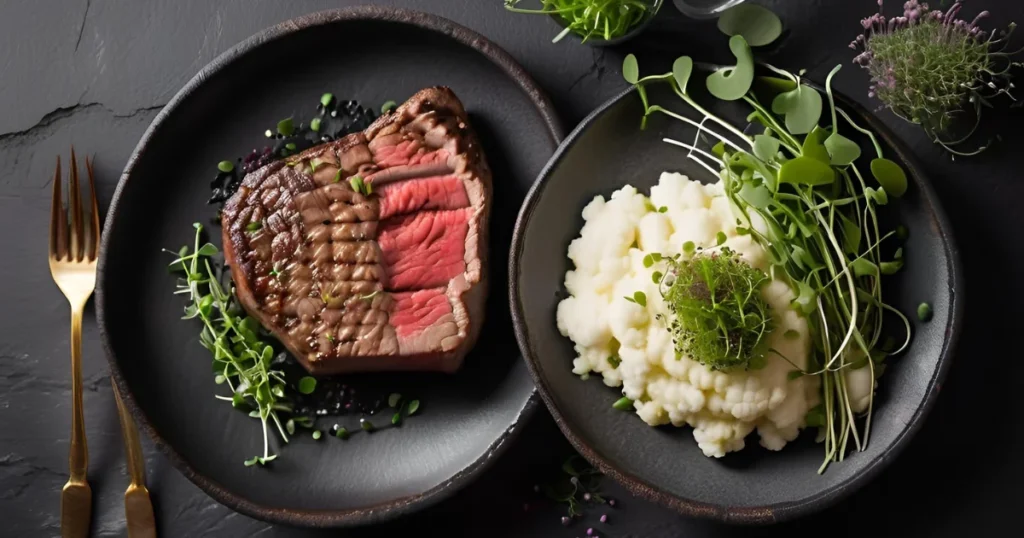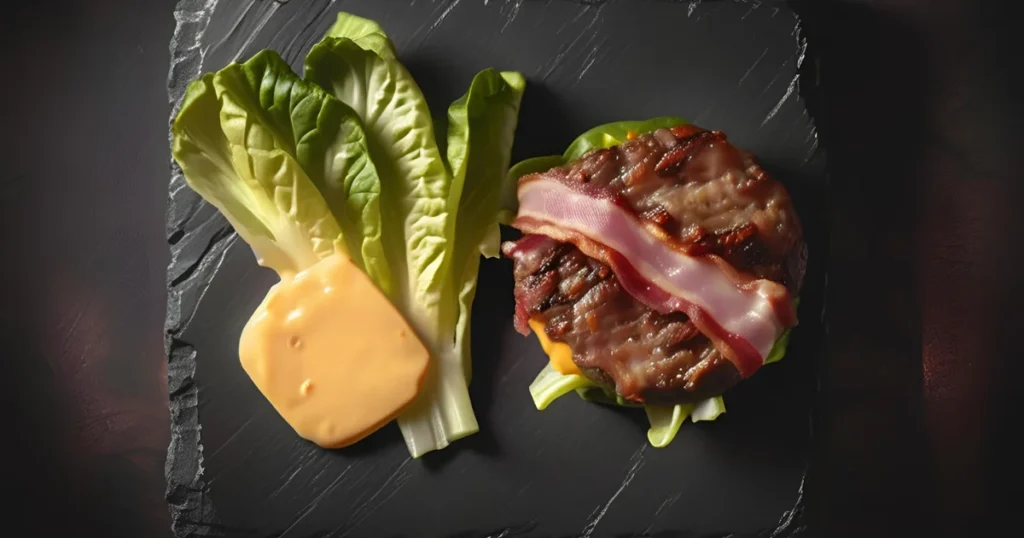Low-Carb Meal Ideas for a Delicious and Healthy Lifestyle
Imagine biting into a warm slice of bread, savoring a creamy pasta dish, or indulging in a hearty bowl of rice—all without the carbs. For many, low-carb eating feels like a trade-off between health and pleasure. But what if you could have both? This article shows how to embrace low-carb living through low-carb meal ideas that taste as good as they are good for you. No more bland salads or deprivation. Here’s how healthy low-carb meals can transform your plate into a feast.

Whether you’re new to this lifestyle or a seasoned follower, you’ll discover strategies to turn cravings into opportunities. From breakfast to dinner, these recipes prove that flavor and nutrition go hand-in-hand. Rethink low-carb eating as a gateway to delicious, goal-supporting meals.
Table of Contents
Understanding the Benefits of a Low-Carb Diet
Low-carb diets improve health through science-backed methods. By reducing refined sugars and processed grains, this dietary shift supports metabolic health and long-term vitality. Recent studies show that choosing healthy low-carb meals can improve biomarkers like blood sugar levels and cholesterol profiles, making them a practical choice for many lifestyles.
Health Advantages of Reducing Carbohydrate Intake
Lower carb consumption has been linked to reduced inflammation and better insulin sensitivity. For individuals with prediabetes or type 2 diabetes, this approach helps stabilize blood glucose without extreme calorie restriction. Research also suggests potential brain health benefits, such as sharper focus and reduced fatigue compared to high-carb diets.
How Low-Carb Diets Support Weight Management
Carb restriction triggers the body to burn stored fat for energy, boosting fat oxidation. This metabolic shift often leads to natural appetite reduction, as stable blood sugar levels curb hunger spikes. Unlike restrictive fad diets, this method promotes sustainable weight loss by aligning with the body’s natural energy systems.
The Science Behind Carb Restriction and Energy Levels
When carb intake drops below 50g daily, the body enters ketosis—a state where fat converts to ketones for fuel. This process minimizes energy crashes common with high-carb meals. Incorporating keto recipes or balanced low-carb meals ensures steady energy, ideal for those seeking consistent daily performance without relying on sugary snacks.
Essential Ingredients for Your Low-Carb Pantry
Building a well-stocked pantry simplifies preparing low-carb snacks and easy low-carb recipes. Start with proteins like grass-fed beef, chicken, and canned tuna for quick meals or snacks. Eggs and Greek yogurt provide versatile options for breakfasts or additions to salads.
- Proteins: Keep jerky, hard-boiled eggs, and salmon in the fridge. Tofu and tempeh offer plant-based options for stir-fries or salads.
- Healthy Fats: Stock olive oil, avocado, and almond butter. To keep nuts and seeds from going bad, store them in airtight containers. Coconut oil is ideal for high-heat cooking.
- Kale and spinach, along with other leafy greens, stay well in the fridge. Quick and easy stir-fries and frittatas can be made with frozen broccoli florets and zucchini.
- Use erythritol or Swerve to sweeten coffee or desserts instead of sugar to prevent sugar rises.
- Shirataki noodles and cauliflower rice are pantry staples that can be used to extend dinner alternatives. Coconut milk with canned tomatoes enhance the flavor of soups and curries.
Organize ingredients by category for quick access. Pre-chop veggies and portion snacks like jerky into bags. This setup ensures you’re always ready to cook without compromising carb counts.
Delicious Low-Carb Breakfast Options to Start Your Day
Starting the day with low-carb meals doesn’t sacrifice taste or time. Traditional breakfasts often rely on carbs like toast and cereals, but these keto recipes and easy low-carb recipes offer satisfying alternatives to keep energy steady all morning.
Quick and Easy Morning Meals Under 10g Carbs
- To make these muffins quickly and easily, just mix together the eggs, spinach, cheese, and bacon. You can split them in half after baking and have them as a portable snack.
- Chia pudding: Combine chia seeds, unsweetened almond milk and vanilla. Wait overnight and drizzle with sugar-free syrup in the morning.
- Yogurt parfait: Layer full-fat Greek yogurt (like Chobani) with nuts and a sprinkle of low-carb granola (try Pamela’s products).

Weekend-Worthy Low-Carb Breakfast Recipes
Weekends deserve indulgence without the carbs. Try:
- Almond flour pancakes: Blend Bob’s Red Mill almond flour with eggs and cream for fluffy stacks, topped with sugar-free maple syrup.
- Savory breakfast casserole: Layer sausage, peppers, onions, and cheese in a skillet for a hearty brunch.
- Portobello “Eggs Benedict: Swap English muffins with grilled portobello caps for a keto recipes twist.
Make-Ahead Breakfast Ideas for Busy Professionals
Prep on Sunday for weekday efficiency:
- Batch-cook easy low-carb recipes like overnight oats (use flaxseed and vanilla extract with unsweetened coconut milk).
- Freeze individual egg muffin portions for quick reheating.
- Assemble breakfast bowls with pre-cooked bacon, avocado, and hard-boiled eggs for 2-minute assembly.
Low-Carb Meal Ideas That Don’t Sacrifice Flavor
Low-carb cooking doesn’t mean sacrificing taste. By leveraging bold seasonings, umami-rich ingredients like garlic and Parmesan, and creative ingredient swaps, you can craft low-carb dinner recipes that please even the most skeptical eaters. Whether cooking for a family or hosting guests, these strategies turn dietary restrictions into culinary adventures.
Family-Friendly Dinners Everyone Will Enjoy
Involve the whole family with interactive meals that adapt to preferences. Try a low-carb dinner recipes like:
- Create your own taco bar with ground beef, shredded lettuce and corn-free tortillas.
- Pizza with cauliflower crust, marinara, mozzarella, and roasted veggies.
- Zucchini noodles tossed with pesto and grilled chicken
Gourmet Options for Special Occasions
Improve carb-free meals using premium ingredients. Impress guests with:
- Herb-crusted salmon with asparagus and butter sauce
- Stuffed mushrooms filled with spinach and feta
- Dark chocolate avocado mousse for dessert
Dietary objectives and indulgence are not mutually exclusive, as these nutritious low-carb meals demonstrate.
Cultural Cuisine Adaptations
Global flavors thrive with smart substitutions. Here’s how to adapt popular dishes:
| Cuisine | Traditional Dish | Low-Carb Version | Example Recipe |
|---|---|---|---|
| Mexican | Beef tacos | Zucchini “tortillas” with ground bison | Serve with pico de gallo and guacamole |
| Asian | Stir-fried rice | Cauliflower rice with soy-ginger glaze | Pair with teriyaki-glazed shrimp |
| Italian | Lasagna | Zucchini lasagna with spinach layers | Layer ricotta, marinara, and mozzarella |
Satisfying Low-Carb Lunch Recipes for Home and Work
Planning low-carb lunch ideas that fit both home and office settings requires balancing flavor, convenience, and nutrition. These meals avoid midday energy crashes while staying true to dietary goals. At home, quick skillet dishes like shrimp stir-fry with broccoli and avocado offer under 10g carbs. Leftover grilled chicken can be transformed into lettuce wraps with salsa and cream cheese for a fresh twist.
For workdays, prioritize portable low-carb meal ideas that stay fresh. Try layered mason jar salads with spinach, cherry tomatoes, cucumber, and grilled chicken—keep dressing separate to prevent sogginess. Pre-portioned containers of hard-boiled eggs, marinated olives, and turkey slices travel well. Opt for microwave-safe options like baked cod with zucchini “noodles” reheated in office kitchens.
| Meal Option | Carb Count | Prep Tip |
|---|---|---|
| Tuna Salad Stuffed Avocado | 3g | Assemble morning of eating to keep creamy |
| Beef and Peppers Stir-Fry | 5g | Use parchment-lined pans for easy cleanup |
| Cottage Cheese Veggie Platter | 4g | Pair with portable hummus packets |
When dining out, choose restaurants offering grilled protein sides or build-your-own salads with low-carb toppings. Always request sauces on the side to control seasoning. Compartmentalized containers like Lock & Lock or Rubbermaid keep components separated until mealtime, ensuring texture and taste. Meal prep Sunday’s leftovers into portioned packs for weekday efficiency. These strategies turn lunch into a satisfying break without derailing progress.
High Protein Low-Carb Meals for Fitness Enthusiasts
For active individuals, fueling workouts and supporting recovery requires more than just calorie counting. High protein low-carb meals provide the amino acids muscles crave while maintaining energy balance. This section explores practical strategies to align nutrition with fitness goals without compromising flavor or results.
Post-workout recovery hinges on timing and nutrient quality. Opt for meals combining fast-digesting protein like grilled chicken or whey protein shakes paired with leafy greens. A spinach and feta omelet topped with turkey bacon can be prepared in less than twenty minutes and provides 25 grams of protein. For endurance athletes, add a small serving of sweet potato to replenish glycogen without overshooting carb limits.
- Muscle-Building Recipes: Try baked salmon with asparagus (12g net carbs) or zucchini noodles topped with turkey meatballs. Both offer over 30g protein per serving.
- Macro Balance Tips: Aim for 1.6-2.2g protein per kg body weight daily. For long-term energy, prioritize foods like lentils, Greek yogurt, and eggs.
Healthy low-carb meals for fitness don’t mean deprivation. Pair avocado slices with hard-boiled eggs for healthy fats and protein. Use almond flour in pancakes to create a post-workout treat under 15g net carbs. Track progress with apps like MyFitnessPal to adjust ratios between workouts and rest days.
Bodybuilders may need more fat during bulking, whereas marathon runners may need more carbs before competition. Always prioritize whole foods first, then consider supplements like branched-chain amino acids (BCAAs) for intense training days.
Smart Low-Carb Meal Prep Strategies for Busy Weeks
Learning low-carb meal planning ensures consistency without effort. Turn weekly cooking into a streamlined process with methods that save time and maintain flavor. Focus on easy low-carb recipes designed for bulk preparation, so every meal feels fresh despite being prepped ahead.
Time-Saving Preparation Techniques
Cut prep time with smart kitchen tools. Use an Instant Pot to cook proteins like chicken or beef in half the usual time. Prep vegetables in bulk: slice zucchini, broccoli, and bell peppers all at once, then store in labeled containers. Marinate meats overnight to simplify morning routines. Parallel prep—like roasting veggies while boiling eggs—minimizes downtime between tasks.
Storage Solutions for Freshness
Enhance storage efficiency with Pyrex airtight containers for refrigerated meals and freezer-safe bags for extended preservation. Freeze pre-cooked proteins in single portions; vacuum-sealed packs (try FoodSaver systems) prevent freezer burn. Blanch greens like spinach before freezing to retain texture. Label containers with dates and meal uses to avoid confusion.
Batch Cooking Guide for Staples
Build a weekly foundation with batch-cooked components. Roast a sheet pan of chicken thighs, sweet potatoes, and Brussels sprouts for three meals. Make a big pot of beef stew using low-sodium broth and store in 2-cup portions. Prep a jar of olive-oil based dressing to toss with greens or proteins. Pair prepped items into easy low-carb recipes like chicken lettuce wraps or zucchini noodle bowls with pre-cooked sauce.
Handling Cravings: Low-Carb Substitutes for High-Carb Foods
Cravings for bread, pasta, and sweets don’t have to derail your low-carb goals. Smart substitutions can satisfy tastes while keeping carbs in check. Here’s how to rethink favorites without sacrificing enjoyment.
For bread cravings, try almond flour-based options like Better Batter or zucchini flatbread. Jimmy Dean Veggie Sausage Links and lettuce wraps are tasty. Low-carb snackslike avocado slices with salt and lime hit the mark too.
Pasta lovers can switch to zucchini noodles (Zoodles) or shirataki noodles (try House Foods Miracel Noodles). For comfort foods, cauliflower rice blends or rutabaga fries (dusted with garlic powder) mimic classic textures. Low-carb meal ideaslike cheese crust pizza with sun-dried tomatoes work for savory fixes.
| Craving | Substitute | Net Carbs | Brand Examples |
|---|---|---|---|
| Bread | Almond flour flatbread | 3g/slice | Against All Grain, WellBeats |
| Pasta | Shirataki noodles | 2g/serving | House Foods, Tofu Shop |
| Sweets | Dark chocolate (85%+ cocoa) | 3g/ounce | Lily’s, Endangered Species |
Sweet cravings? Opt for flaxseed energy balls (made with sunflower seed butter) or Enjoy Life Dark Chocolate Chips (1g net carbs per tbsp). in recipes). Adjust expectations: some substitutes taste similar, others offer new textures. Experiment with spices like paprika or nutritional yeast to boost flavor without carbs.
Conclusion: Embracing a Sustainable Low-Carb Lifestyle
Choosing low-carb doesn’t imply compromising taste or flexibility. The low-carb meal ideas explored in this guide prove that healthy low-carb meals can be both satisfying and varied. Focus on balance by tailoring carb intake to your unique needs—whether you’re active, managing health goals, or simply seeking better energy levels.
Staying consistent requires creativity. Avoid monotony by experimenting with the recipes shared here, from zucchini noodles to protein-packed bowls. When social events arise, plan ahead with portable snacks or low-carb alternatives to stay on track without feeling deprived. Remember, small adjustments like tracking energy shifts or carb counts can highlight what works best for you.
Successful low-carb eating thrives on adaptability. Explore substitutions for classic dishes, like almond flour for pasta or avocado-based sauces, to keep meals exciting. Prioritize whole foods and mindful eating to build a routine that feels natural. Whether you’re refining your approach weekly or monthly, flexibility ensures this way of eating becomes a long-term habit rather than a fleeting trend.
